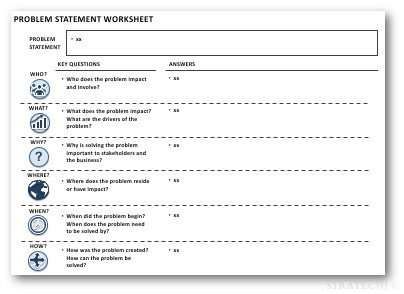Learn everything you need to know to develop a Problem Statement by an Ex-McKinsey consultant. Includes best practices, examples, and a free problem statement template at the bottom.
“A problem well stated is a problem half solved.”
– Charles Kettering, Early 1900s American Inventor
I remember my first day on my first project at McKinsey, the partner got the team in a room for us to spend a few hours “defining the problem statement.” At first, I thought to myself, “man, what a dumb idea…this client is paying us millions of dollars, and we don’t even know what we are trying to solve?” But, as we started to debate the context of the client, the issues they faced, and the reasons why they brought us on, I started to appreciate defining the problem statement and the ability for the right problem statement to frame and focus problem solving.
What is a problem statement?
A problem statement is a clear description of the problem you are trying to solve and is typically most effectively stated as a question. Problem statements are subtly critical in effective problem solving. They have an uncanny ability in focusing the efforts of brainstorming, teamwork, and projects.
To understand this better, let’s go through some examples of how you can position a brainstorming session on various topics.
Beyond brainstorming, problem statements should be used at the beginning of any project to frame and focus on the problem. A good problem statement defines the “who” the problem involves, and defines the scope of the problem. Since problem statements guide much of the problem solving of a project, it is important not to be too narrow or broad with the problem statement.
How do you create an effective problem statement?
As stated before, every McKinsey project starts with the development of a problem statement. Once we landed on a strong problem statement, then we had to align the client with the problem statement. The easiest way for a project and team to get off track is if the team and the client are trying to solve different problems. A good problem statement aligns the expectations of the client with the team’s activities and output.
Here are the best practices when creating an effective problem statement:
Use the 5 Ws and one H
One of the most useful tools when developing a problem statement is the 5 Ws and one H, which is simply utilizing who, what, why, where, when, and how questions to frame the problem statement. Simply thinking through these questions as they relate to the problem can help you create a strong problem statement.
Ask the most crucial question, “What are we trying to solve?”
We’ve all been in those brainstorming sessions, meetings or on those projects, where you’re just scratching your head, as the conversation or directions are more like an Olympic ping-pong match going from one topic to the next. The most effective question that I’ve used in over a thousand meetings and conversations is simply “what are we trying to solve?” It cuts through the clutter, confusion, and misalignment, and quickly centers the focus and energy of everyone.
Frame the problem statement as a goal
Some of the best problem statements are simply goals formatted as questions. If you need to increase sales by 10%, a good problem statement is, “Within the next 12 months, what are the most effective options for the team to increase sales by 10%?”
Force the prioritization
Often, the most effective problem statements force the prioritization of issues and opportunities. Using phrases such as “the most important for the customer” or “the best way” will force prioritization.
DOWNLOAD THE PROBLEM STATEMENT POWERPOINT WORKSHEET
To get you going on defining a strong problem statement, download the free and editable Problem Statement PowerPoint Worksheet.
Correctly defining a problem statement at the beginning of a project or initiative will dramatically improve the success of the project or initiative. Problem statements help guide problem solving, analysis, hypotheses, and solutions.
Developing a problem statement is an iterative brainstorming process. Get the major stakeholders in a room for a few hours and start the process by having everyone write down what they think the problem is on index cards. Collect the index cards and post them on a whiteboard. You can either discuss each one or have the group pick the top 3 and then discuss them. You can use the Problem Statement Worksheet to further define the problem by answering the 5 Ws and 1 H. The key is to find the right problem statement all stakeholders feel strongly about, in that, if the problem statement were solved, the problem would be solved.
Learn more about Joe Newsum, the author of all this free content and a McKinsey Alum. I provide a suite of coaching and training services to realize the potential in you, your team, and your business. Learn more about me and my coaching philosophy.
The ultimate model and guide to elevate your leadership team. Take the assessments to understand your team's maturity.



